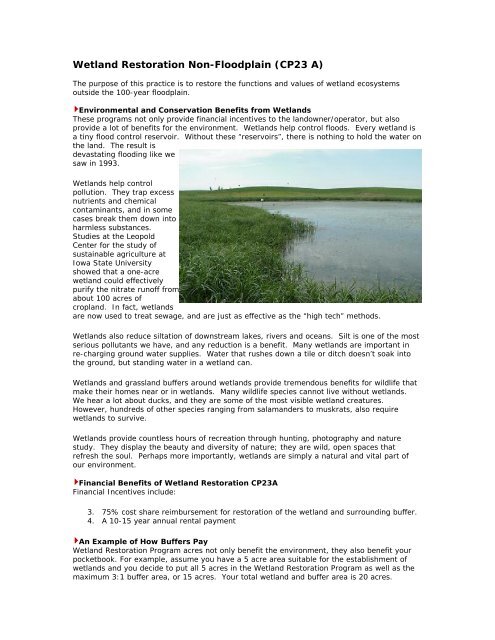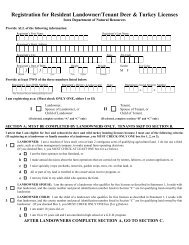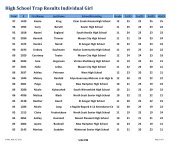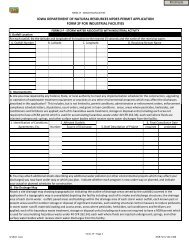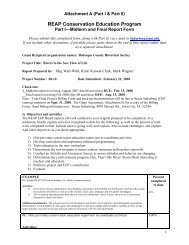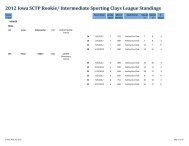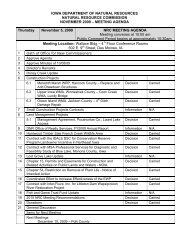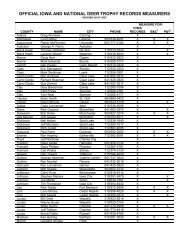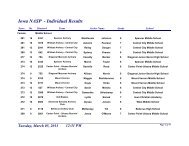Wetland Restoration Non-Floodplain (CP23 A) - Iowa Department of ...
Wetland Restoration Non-Floodplain (CP23 A) - Iowa Department of ...
Wetland Restoration Non-Floodplain (CP23 A) - Iowa Department of ...
You also want an ePaper? Increase the reach of your titles
YUMPU automatically turns print PDFs into web optimized ePapers that Google loves.
<strong>Wetland</strong> <strong>Restoration</strong> <strong>Non</strong>-<strong>Floodplain</strong> (<strong>CP23</strong> A)<br />
The purpose <strong>of</strong> this practice is to restore the functions and values <strong>of</strong> wetland ecosystems<br />
outside the 100-year floodplain.<br />
Environmental and Conservation Benefits from <strong>Wetland</strong>s<br />
These programs not only provide financial incentives to the landowner/operator, but also<br />
provide a lot <strong>of</strong> benefits for the environment. <strong>Wetland</strong>s help control floods. Every wetland is<br />
a tiny flood control reservoir. Without these “reservoirs”, there is nothing to hold the water on<br />
the land. The result is<br />
devastating flooding like we<br />
saw in 1993.<br />
<strong>Wetland</strong>s help control<br />
pollution. They trap excess<br />
nutrients and chemical<br />
contaminants, and in some<br />
cases break them down into<br />
harmless substances.<br />
Studies at the Leopold<br />
Center for the study <strong>of</strong><br />
sustainable agriculture at<br />
<strong>Iowa</strong> State University<br />
showed that a one-acre<br />
wetland could effectively<br />
purify the nitrate run<strong>of</strong>f from<br />
about 100 acres <strong>of</strong><br />
cropland. In fact, wetlands<br />
are now used to treat sewage, and are just as effective as the “high tech” methods.<br />
<strong>Wetland</strong>s also reduce siltation <strong>of</strong> downstream lakes, rivers and oceans. Silt is one <strong>of</strong> the most<br />
serious pollutants we have, and any reduction is a benefit. Many wetlands are important in<br />
re-charging ground water supplies. Water that rushes down a tile or ditch doesn’t soak into<br />
the ground, but standing water in a wetland can.<br />
<strong>Wetland</strong>s and grassland buffers around wetlands provide tremendous benefits for wildlife that<br />
make their homes near or in wetlands. Many wildlife species cannot live without wetlands.<br />
We hear a lot about ducks, and they are some <strong>of</strong> the most visible wetland creatures.<br />
However, hundreds <strong>of</strong> other species ranging from salamanders to muskrats, also require<br />
wetlands to survive.<br />
<strong>Wetland</strong>s provide countless hours <strong>of</strong> recreation through hunting, photography and nature<br />
study. They display the beauty and diversity <strong>of</strong> nature; they are wild, open spaces that<br />
refresh the soul. Perhaps more importantly, wetlands are simply a natural and vital part <strong>of</strong><br />
our environment.<br />
Financial Benefits <strong>of</strong> <strong>Wetland</strong> <strong>Restoration</strong> <strong>CP23</strong>A<br />
Financial Incentives include:<br />
3. 75% cost share reimbursement for restoration <strong>of</strong> the wetland and surrounding buffer.<br />
4. A 10-15 year annual rental payment<br />
An Example <strong>of</strong> How Buffers Pay<br />
<strong>Wetland</strong> <strong>Restoration</strong> Program acres not only benefit the environment, they also benefit your<br />
pocketbook. For example, assume you have a 5 acre area suitable for the establishment <strong>of</strong><br />
wetlands and you decide to put all 5 acres in the <strong>Wetland</strong> <strong>Restoration</strong> Program as well as the<br />
maximum 3:1 buffer area, or 15 acres. Your total wetland and buffer area is 20 acres.
If your soil rental rate is $165/acre at the end <strong>of</strong> a fifteen year period you will receive from<br />
your rental payment $2,475 per acre or a total <strong>of</strong> $49,500.<br />
Do I Qualify for the Continuous CRP<br />
The continuous Conservation Reserve Program (CRP) is administered through the United<br />
States <strong>Department</strong> <strong>of</strong> Agriculture Farm Service Agency (FSA).<br />
Do I qualify?<br />
You qualify for the continuous CRP if your land is:<br />
1. You have cropland that was planted or considered planted to agricultural commodities<br />
4 <strong>of</strong> 6 years between 1996 and 2001.<br />
2. Must cropland must be suitably located and adaptable to the establishment <strong>of</strong><br />
wetlands outside <strong>of</strong> the 100 year floodplain.<br />
3. Participants must agree to restore the hydrology <strong>of</strong> the wetland to the maximum<br />
extent possible.<br />
When can I sign-up?<br />
Offers for the continuous CRP are automatically accepted. If your land qualifies and if you are<br />
satisfied with the rental rates you are in the program.<br />
Where do I sign up?<br />
You can sign-up at your county FSA <strong>of</strong>fice. It is a good idea to call in advance for an<br />
appointment to avoid a long wait or a wasted trip. If you want some help determining if you<br />
are eligible for the program before talking with FSA, a trip to your county NRCS <strong>of</strong>fice or a visit<br />
from your Wildlife Specialist would be a good idea.<br />
Where Do I Get Help in Designing My <strong>Wetland</strong><br />
Assistance for planning and installing your wetland is available from the USDA NRCS staff or<br />
the IDNR Wildlife Bureau Private Lands Program. Contact your local NRCS <strong>of</strong>fice or your<br />
Wildlife Specialist for assistance. Your Wildlife Specialist can meet with you on your property<br />
and design a plan for your project that will design both the wetland restoration as well as the<br />
grassland buffer including matching grass and forb species to the planting site, provide site<br />
preparation and maintenance information. Your Wildlife Specialist can also provide you with a<br />
list <strong>of</strong> local contractors as well as seed dealers.<br />
Contact your Wildlife Specialist<br />
(http://www.iowadnr.gov/wildlife/privatelands/staff.html)<br />
Where Do I Get <strong>Iowa</strong> grass and forb seed<br />
When undertaking any grassland restoration project it is always best to utilize <strong>Iowa</strong> native<br />
plant material. These grasses and forbs will be better adapted to our climate and growing<br />
conditions than seeds from other regions <strong>of</strong> the country. There are several excellent sources<br />
for purchasing <strong>Iowa</strong> native grass and forb seeds available for your wetland buffer planting.<br />
Your Wildlife Specialist can provide you with a list <strong>of</strong> local seed dealers.


